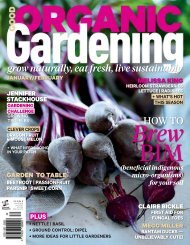3. Good Organic Gardening - May-June 2016 AvxHome.in
3. Good Organic Gardening - May-June 2016 AvxHome.in
3. Good Organic Gardening - May-June 2016 AvxHome.in
Create successful ePaper yourself
Turn your PDF publications into a flip-book with our unique Google optimized e-Paper software.
Edibles <strong>in</strong> conta<strong>in</strong>ers | WEEKEND GARDENING<br />
Pots and conta<strong>in</strong>ers<br />
Size matters. The smaller the pot, the quicker<br />
it can dry out and the choice of plant you<br />
are grow<strong>in</strong>g is a factor to consider also. A tall<br />
cherry tomato isn’t go<strong>in</strong>g to come to fruition<br />
<strong>in</strong> a t<strong>in</strong>y 100mL pot, for example. So consider<br />
what it is you want to grow and what the size<br />
these edibles are at maturity. Larger pots will<br />
generally give you better results.<br />
Plastic or terracotta? The choice is vast<br />
these days, with the type and variety of<br />
conta<strong>in</strong>ers and grow<strong>in</strong>g set-ups available to<br />
the home gardener. Plastic won’t dry out as<br />
quickly as terracotta, but you may prefer the<br />
look of a ceramic or terracotta pot. One way<br />
around this is to plant <strong>in</strong> the plastic pot but<br />
sit it <strong>in</strong>side the decorative pot to get the best<br />
of both worlds.<br />
Large pots once filled with soil and plants<br />
will be usually very heavy and a challenge to<br />
move. Consider pot stands with wheels on<br />
the bottom.<br />
There are also some great alternatives<br />
to pots:<br />
Green-wall set-ups are excellent options<br />
for us<strong>in</strong>g every square <strong>in</strong>ch of space of<br />
a verandah, courtyard, empty wall, fence<br />
or lattice. Some even have their own<br />
irrigation system.<br />
Stacker pots are like giant oversized<br />
strawberry planters of old.<br />
Trough stands are another great way to<br />
use every bit of space by hav<strong>in</strong>g multiple<br />
long troughs stacked and locked <strong>in</strong>to place<br />
on a metal stand.<br />
Baskets, whether hang<strong>in</strong>g or wall types,<br />
can also be used to grow edibles.<br />
Balcony planter holders are a good way<br />
to use your verandah rail<strong>in</strong>gs as grow<strong>in</strong>g<br />
space. These are made to either hook on<br />
or drill <strong>in</strong>to place metal frames <strong>in</strong> which you<br />
place your pot or trough.<br />
Balcony pots go the next step and do away<br />
with the need for a holder/bracket as the<br />
pot itself slots over the rail<strong>in</strong>g and is held <strong>in</strong><br />
place with a few screws.<br />
Freestand<strong>in</strong>g planter troughs are usually<br />
on legs, which makes them easier to<br />
ma<strong>in</strong>ta<strong>in</strong> and keeps them off the ground.<br />
Potted lettuce<br />
can look quite<br />
decorative<br />
Tomatoes do well <strong>in</strong><br />
pots, especially self<br />
water<strong>in</strong>g types<br />
Some have self-water<strong>in</strong>g reservoirs too.<br />
Get creative and do some upcycl<strong>in</strong>g of old<br />
jeans, boots, laundry tubs, wheelbarrows,<br />
pallets and suitcases to use them as vessels<br />
for grow<strong>in</strong>g plants.<br />
Note: Dra<strong>in</strong>age holes are essential and need<br />
to be checked when choos<strong>in</strong>g or mak<strong>in</strong>g<br />
your conta<strong>in</strong>ers.<br />
For water edibles, seal up dra<strong>in</strong>age holes or<br />
choose a pond bowl with no dra<strong>in</strong>age holes and<br />
you have an <strong>in</strong>stant water feature <strong>in</strong> which you<br />
can grow edibles such as water chestnuts, kang<br />
kong, Vietnamese m<strong>in</strong>t and watercress. You also<br />
provide water for bees, frogs and other<br />
t<strong>in</strong>y creatures..<br />
Pott<strong>in</strong>g mixes<br />
You really do get what you pay for when it<br />
comes to pott<strong>in</strong>g mixes. I always suggest<br />
purchas<strong>in</strong>g a mix that has all the Australian<br />
standards ticks on the side of the bag. These<br />
high-quality pott<strong>in</strong>g mixes have good waterhold<strong>in</strong>g<br />
capacity, as well as slow-release<br />
fertilisers and re-wett<strong>in</strong>g agents. They are made<br />
with clean, good-quality <strong>in</strong>gredients. Some may<br />
Radishes<br />
grown <strong>in</strong> a pot<br />
arkliv<strong>in</strong>g pots are<br />
designed for those<br />
with no garden<br />
who still want to<br />
enjoy homegrown<br />
Plants grown <strong>in</strong> pots generally require<br />
more water and fertiliser.<br />
even have water crystals added. There a few<br />
certified-organic mixes available also.<br />
Look for the Australian Certified symbol<br />
on the front of the bag. Just hav<strong>in</strong>g the<br />
word “organic” on the label doesn’t mean it’s<br />
certified organic. The same goes for sprays<br />
and fertilisers.<br />
Fertilisers<br />
Most pott<strong>in</strong>g mixes will have a certa<strong>in</strong> amount<br />
of slow-release fertiliser <strong>in</strong> them but to get<br />
the optimum growth and harvest out of your<br />
edibles, you need to fertilise with a quickeract<strong>in</strong>g<br />
liquid fertiliser such as fish emulsion or<br />
other organic options such as compost tea and<br />
worm wee.<br />
The addition of liquid seaweed, which acts<br />
as a plant health tonic, is highly recommended.<br />
Top-ups of slow-release organic fertilisers may<br />
be needed, depend<strong>in</strong>g on how long your crops<br />
take to grow or what the lifespan of the plant is.<br />
For example, a fruit<strong>in</strong>g tree or long-lived herbs<br />
such as rosemary have different requirements,<br />
both from each other and from a fruit<strong>in</strong>g annual.<br />
Water<strong>in</strong>g<br />
Plants <strong>in</strong> conta<strong>in</strong>ers are reliant on you for most<br />
of their needs and water<strong>in</strong>g is at the top of the<br />
list. How often and how much will depend on<br />
many factors, <strong>in</strong>clud<strong>in</strong>g size and material of the<br />
pot/conta<strong>in</strong>er, plant species, season, weather<br />
conditions, pott<strong>in</strong>g mix quality and so forth.<br />
How to know whether you need to water<br />
can be tricky, though it can be easy enough if<br />
the plants are droop<strong>in</strong>g. This is not a good sign<br />
to rely on because once a plant is at droop<strong>in</strong>g<br />
stage, it’s becom<strong>in</strong>g stressed, leav<strong>in</strong>g it more
















